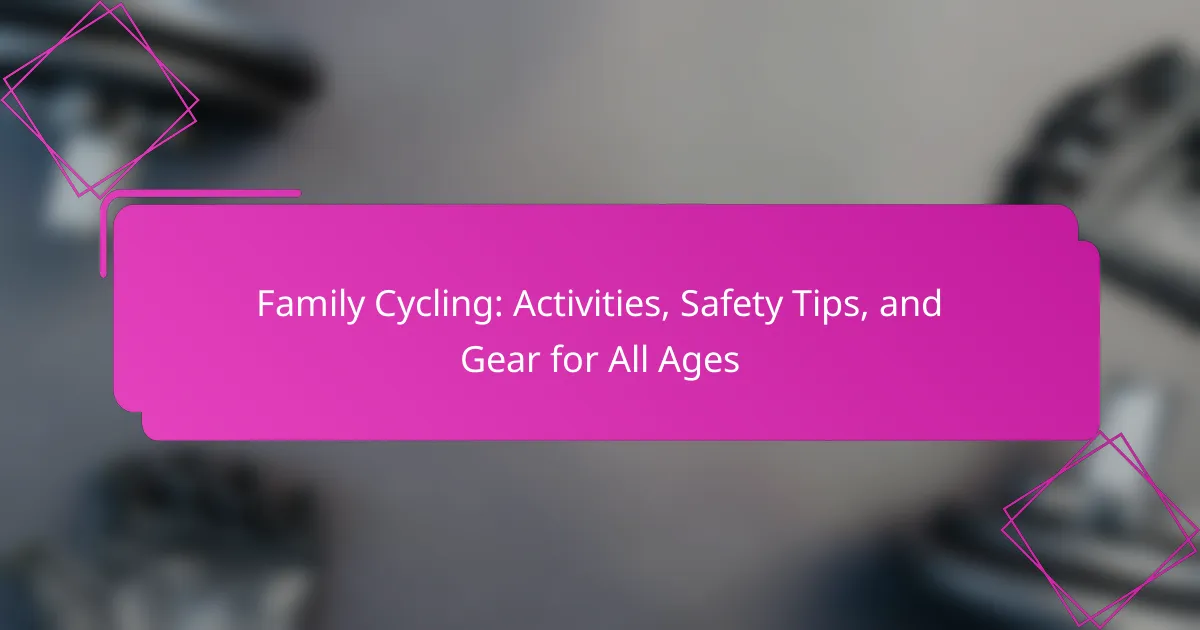Family cycling offers health benefits, strengthens family bonds, and enhances mental well-being. This article covers essential safety tips, suitable gear for all ages, and engaging activities tailored to different skill levels. Learn how to choose the right bicycles, plan inclusive routes, and maintain your cycling equipment for enjoyable outings.

What are the benefits of family cycling activities?
Family cycling activities provide numerous benefits, including improved physical fitness, enhanced family bonding, and increased mental well-being. Engaging in cycling promotes cardiovascular health and muscle strength for all ages. It also encourages teamwork and communication among family members. Additionally, cycling in nature can reduce stress and improve mood, contributing to overall family happiness.
How does family cycling promote physical health?
Family cycling significantly enhances physical health by promoting cardiovascular fitness and muscle strength. Engaging in cycling activities fosters endurance and coordination, benefiting all family members. Regular cycling can reduce obesity risks, improve mental health, and strengthen family bonds through shared experiences. Additionally, cycling outdoors exposes families to fresh air and nature, which contributes to overall well-being.
What social benefits does family cycling provide?
Family cycling fosters strong social bonds and enhances community engagement. It encourages family members to spend quality time together, improving communication and cooperation. Participating in group rides can create connections with other families, promoting a sense of belonging. Additionally, cycling activities often lead to increased physical activity, which contributes to overall well-being and social interaction in local parks or cycling events.
Why is family cycling an effective way to bond?
Family cycling is an effective way to bond because it promotes teamwork, communication, and shared experiences. Engaging in cycling together allows family members to support each other, enhancing relationships. This activity encourages physical fitness, which can lead to improved mood and overall well-being. Additionally, the shared adventure of exploring new trails fosters lasting memories, strengthening family ties.

What safety precautions should families take while cycling?
Families should take several safety precautions while cycling to ensure a safe experience. Always wear properly fitted helmets to protect against head injuries. Use bright, reflective clothing to enhance visibility, especially in low-light conditions. Ensure bicycles are in good working condition, checking brakes and tires before each ride. Establish clear communication signals among family members for safe turns and stops. Choose safe routes, such as bike paths or quiet streets, to minimize traffic exposure. Lastly, educate children about road rules and safe cycling practices.
How can families ensure safe routes for cycling?
Families can ensure safe routes for cycling by planning routes with low traffic and well-maintained paths. Use designated bike lanes and avoid busy roads whenever possible. Educate children on road safety, including hand signals and traffic rules. Regularly check bikes for proper functioning, including brakes and tires.
What are essential safety gear recommendations for all ages?
Essential safety gear for family cycling includes helmets, reflective vests, knee and elbow pads, and lights. These items protect against injuries and enhance visibility.
1. Helmets: Protects the head from impacts.
2. Reflective vests: Increases visibility in low-light conditions.
3. Knee and elbow pads: Reduces injury risk during falls.
4. Lights: Ensures safety during night rides.
Choosing age-appropriate gear enhances safety for all cyclists.
How should families teach children about cycling safety?
Families should teach children about cycling safety by emphasizing rules, proper gear, and awareness. Start with basic rules like riding with traffic and using hand signals. Ensure children wear helmets and reflective clothing for visibility. Teach them to be aware of their surroundings, including checking for vehicles and pedestrians. Practice safe riding in controlled environments before venturing onto busy roads. Reinforce these lessons regularly to build confidence and understanding.

Which types of bicycles are best for family cycling?
Hybrid bicycles, mountain bikes, and cargo bikes are best for family cycling. These types offer versatility, comfort, and safety for all ages.
Hybrid bicycles combine features of road and mountain bikes, making them suitable for various terrains. They typically have a comfortable seating position and wider tires, enhancing stability. Mountain bikes provide robust frames and shock-absorbing capabilities, ideal for off-road adventures. Cargo bikes can carry additional passengers or gear, promoting family outings and picnics.
When selecting a bicycle, consider attributes like frame size, weight capacity, and safety features. Ensuring proper fit enhances comfort and control, making family cycling enjoyable for everyone.
What are the advantages of cargo bikes for families?
Cargo bikes offer numerous advantages for families, enhancing convenience and safety. They provide ample storage for children and gear, making outings easier. Cargo bikes promote family bonding through shared cycling experiences. They also reduce reliance on cars, contributing to environmental sustainability. Additionally, they often feature stability and safety enhancements, ideal for transporting kids.
How do tandem bikes cater to different age groups?
Tandem bikes effectively cater to different age groups by offering adjustable seating and handlebars. These features accommodate both children and adults, ensuring comfort and safety. Families can enjoy cycling together, promoting bonding and physical activity. Tandem bikes also enhance coordination and communication between riders, making them ideal for various skill levels.
What features should parents look for in children’s bikes?
Parents should look for safety features, appropriate sizing, and durability when choosing children’s bikes. Safety features include reflectors, bells, and brakes. Bikes should be the right size to ensure comfort and control, allowing children to reach the ground easily. Durability is crucial for withstanding rough use. Additional features like adjustable seats and lightweight frames enhance usability and longevity.

How can families plan cycling activities for different age groups?
Families can plan cycling activities by tailoring routes and challenges to different age groups. Consider these strategies for inclusive cycling experiences.
1. Choose age-appropriate trails. Select flat, paved paths for younger children and more challenging terrain for teens.
2. Incorporate fun elements. Plan scavenger hunts or themed rides to engage younger cyclists and maintain interest.
3. Ensure safety gear. Provide helmets and reflective clothing for all ages to promote safety during rides.
4. Set group pace. Establish a comfortable speed that accommodates the slowest rider, ensuring everyone enjoys the experience together.
What age-appropriate cycling routes are available for families?
Family-friendly cycling routes include parks, dedicated bike paths, and scenic trails suitable for all ages. Popular options are local parks like Central Park, which offer safe, car-free zones, and regional trails such as the Great Allegheny Passage, featuring gentle inclines and beautiful scenery. Additionally, many cities provide family-oriented cycling events that promote safe riding while exploring community routes. Always check local resources for specific age-appropriate recommendations and safety guidelines.
How can families incorporate cycling into weekend outings?
Families can incorporate cycling into weekend outings by planning fun routes, ensuring safety, and selecting appropriate gear. Start by choosing scenic trails or parks that cater to all ages and skill levels.
Engage children by organizing games or challenges during the ride, such as scavenger hunts or timed races. For safety, ensure everyone wears helmets and follows traffic rules.
Invest in suitable gear, like child seats or trailers for younger kids. Consider bike rentals if you don’t own enough bikes.
Lastly, schedule regular outings to build a cycling routine, enhancing family bonding and fitness.
What events or festivals celebrate family cycling?
Events and festivals that celebrate family cycling include community bike rides, cycling festivals, and charity bike events. These gatherings promote family bonding, cycling safety, and healthy lifestyles. Notable examples are the National Bike Month in May, the Family Cycling Festival, and local bike parades. Many of these events feature activities like bike safety workshops, group rides, and entertainment for all ages, encouraging families to engage in cycling together.

What unique challenges do families face in cycling?
Families face unique challenges in cycling, including safety concerns, varying skill levels, and equipment needs. Safety is paramount, especially for children. Parents must ensure proper helmet use and choose safe routes. Different ages and abilities require tailored activities, making it essential to find routes suitable for all family members. Additionally, finding appropriate gear, like child seats or trailers, can be complicated. Budget constraints can also limit access to quality equipment. Balancing these factors is crucial for an enjoyable family cycling experience.
How can families manage varying skill levels in cycling?
Families can manage varying skill levels in cycling by creating a supportive environment and adjusting activities. Start with group rides that accommodate all abilities. Use trails with different difficulty levels to ensure everyone can participate comfortably.
Incorporate activities like relay races or obstacle courses that promote teamwork while allowing individuals to shine at their skill level. Provide appropriate gear, such as adjustable bikes and safety equipment, to enhance comfort and safety for all ages.
Encourage regular practice sessions that focus on skill development, ensuring that more experienced cyclists can mentor beginners. Celebrate progress, fostering a positive atmosphere that motivates family members to improve together.
What solutions exist for cycling with young children?
Various solutions exist for cycling with young children, ensuring safety and enjoyment. Options include child seats for toddlers, bike trailers for multiple kids, and tag-along bikes for older children. Each solution offers unique benefits tailored to different age groups and family needs. Child seats provide close supervision, bike trailers offer stability and storage, while tag-along bikes promote independence. Choosing the right gear enhances the family cycling experience, making it enjoyable for all ages.

What rare cycling gear options can enhance family cycling experiences?
Rare cycling gear options that can enhance family cycling experiences include cargo bikes, which offer ample space for children and gear, and adaptive cycles designed for individuals with disabilities. Electric assist bicycles help families tackle hilly terrains effortlessly. Tandem bikes encourage teamwork and bonding among family members. Specialized child seats with safety features ensure secure rides for younger cyclists. Finally, bike trailers provide a safe and comfortable way to transport kids or pets, enhancing the overall cycling experience.
How can technology improve family cycling safety and enjoyment?
Technology enhances family cycling safety and enjoyment through various tools and innovations. Smart helmets with integrated lights and communication systems improve visibility and connectivity. GPS-enabled devices offer real-time tracking, ensuring families stay together during rides. Mobile apps provide route planning and safety alerts, enhancing overall experience. Additionally, bike-mounted cameras can record rides, promoting safety awareness and accountability. These advancements foster a safer and more enjoyable cycling environment for families.
What innovative accessories are available for family cyclists?
Innovative accessories for family cyclists enhance safety and enjoyment. Options include child seats, bike trailers, safety flags, handlebar bags, and reflective gear. These accessories ensure a comfortable ride for all ages while prioritizing safety and convenience.

What are the best practices for maintaining family cycling gear?
To maintain family cycling gear effectively, regularly clean, inspect, and store equipment properly. Clean bikes after each ride to remove dirt and debris. Check tire pressure and brakes before every outing. Store gear in a dry, cool location to prevent rust and wear. Use protective covers for bikes and helmets when not in use. Regularly lubricate chains and moving parts to ensure smooth operation. Consider scheduling professional tune-ups annually for optimal performance.
How often should families service their bicycles?
Families should service their bicycles at least once a year. Regular maintenance ensures safety and enhances performance. Key tasks include checking brakes, tires, and gears. For frequent riders or those using bicycles in varied conditions, servicing every six months is advisable. This frequency helps identify wear and tear early, ensuring a safe cycling experience for all family members.
What common mistakes should families avoid while cycling?
Families should avoid common mistakes like neglecting safety gear, cycling without a plan, and ignoring traffic rules. Ensuring proper equipment and communication among family members enhances safety and enjoyment. Prioritize choosing safe routes and maintaining bicycles regularly to prevent accidents. Additionally, avoid overestimating children’s cycling abilities to ensure a positive experience.
How can families ensure their cycling gear is suitable for all ages?
Families can ensure their cycling gear is suitable for all ages by selecting adjustable equipment and prioritizing safety features. Choose bikes with adjustable seat heights and handlebars to accommodate growth. Look for helmets that meet safety standards and are lightweight for comfort. Opt for gear made from breathable materials to enhance comfort during rides. Regularly check the fit of gear as children grow, ensuring it remains functional and safe. Consider family-friendly accessories like trailers or child seats that promote shared cycling experiences.
